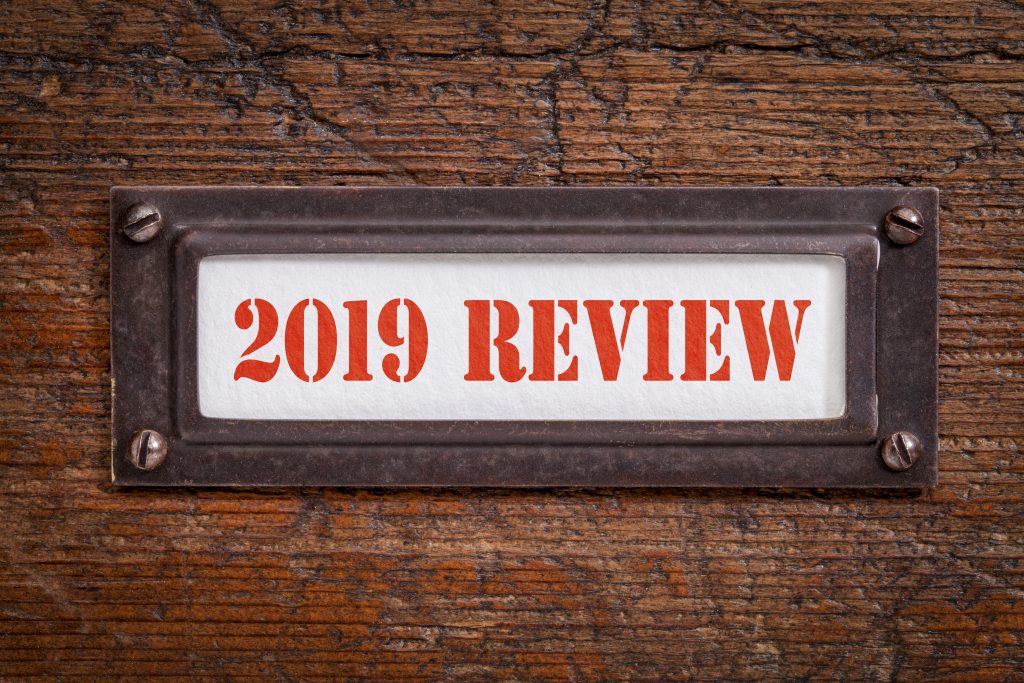“More 101 reforms may well be needed, but most would agree we are better off today than we were a year ago because of the actions taken by the USPTO.”
 As the year draws to a close, we reflect on what mattered most in the world of intellectual property during 2019. It was a particularly active year on IP issues, with important events in the courts, Congress, and agencies. Below we have highlighted a few of the most significant activities. Compare our list to yours and let us know what you think!
As the year draws to a close, we reflect on what mattered most in the world of intellectual property during 2019. It was a particularly active year on IP issues, with important events in the courts, Congress, and agencies. Below we have highlighted a few of the most significant activities. Compare our list to yours and let us know what you think!
Administration and Congressional Consideration of Patent Subject Matter 101 Issues
One of the first things that the USPTO did this year – and one of the most important – was to issue revised guidance both for subject matter eligibility under 35 U.S.C. § 101 and the application of 35 U.S.C. § 112 to computer-implemented inventions. The guidance went into effect January 7, 2019—a “new year’s present” for all of us.? The agency’s action, according to USPTO Director Iancu, was designed to improve the clarity, consistency, and predictability of Section 101 and 112 actions throughout the USPTO. The agency also provided training throughout the year to examiners and administrative patent judges to help ensure the guidance was being properly and consistently administered.
Then, in May, Sens. Tillis (R-NC) and Coons (D-DE), alongside Reps. Collins (R-GA), Johnson (D-GA), and Stivers (R-OH) released a bipartisan, bicameral draft bill that would not only make further reforms to Section 101 of the Patent Act, but, unlike agency guidance, would enshrine them into law.
The bill made the following specific changes:
- Removed “new” from section 101
- Added 101(b) to provide that eligibility determinations are to be based on the claim as a whole
- Added section 100(k) to define the usefulness requirement
- Amended section 112(f)
Sens. Tillis and Coons held several hearings and closed-door roundtables with stakeholders to solicit feedback on potential reform. Technology, pharmaceutical and biotechnology industry representatives lauded the proposed changes as a way to boost innovation and eliminate business uncertainty. On the other hand, other groups have asked the lawmakers to maintain the status quo.
The guidance issued by the USPTO and the time that Congress spent considering further 101 reforms reflected the unhappy state of 101 jurisprudence at the end of last year. More 101 reforms may well be needed, but most would agree we are better off today than we were a year ago because of the actions taken by the USPTO. These issues are very important to the intellectual property community. As a consequence, we believe that the agency’s actions relating thereto, and Congress’s’ expression of interest therein, were the most important intellectual property development in 2019.
USPTO Hires New CIO and Continues Modernization of IT Systems
In February of this year, the USPTO hired Jamie Holcombe as its new Chief Information Officer (CIO). The job had been held in acting capacity by David Chiles following the departure of John Owens in October 2017.
The CIO role is a vitally important one, particularly in an organization like the USPTO, where the work of its examiners and applicants is increasingly digital. Thus far, Holcombe has shown a strong understanding of this transformation and has articulated a clear plan to stabilize and modernize the IT systems. He has also demonstrated strong management and leadership skills and an absolute commitment to mission success. We hope that he is given the necessary funding and support to realize his plan.
Senate Judiciary IP Subcommittee is Reinstated
The beginning of the 116th Congress brought the reinstatement of the Senate Judiciary Subcommittee on Intellectual Property, which had been disbanded in 2007. The Subcommittee is led by Chairman Thom Tillis (R-NC) and Ranking Member Chris Coons (D-DE), two lawmakers with a clear understanding of both the vital importance of a robust IP system and the unique challenges facing stakeholders.
To their credit, Sens. Tillis and Coons wasted no time getting to work. In just a year they have held 12 congressional hearings on IP issues, such as patent subject matter eligibility, as referenced above, and sent 10 letters to various agency heads. The quantity and variety of the Senate Subcommittee actions sent a strong message that IP protection is of great important to the U.S. economy and U.S. workers.
IP Legislation Moves through Congress
In a further indication that intellectual property remains one of the few areas where legislation can advance through Congress, there appears to be bipartisan recognition of the importance of some of the issues and the need for reform, or at least clarification. Thus, this past May, a bipartisan group of lawmakers, led by Reps. Hakeem Jeffries (D-NY) and Doug Collins (R-GA) in the House and Sens. John Kennedy (R-LA) and Dick Durbin (D-IL) in the Senate, introduced the Copyright Alternative in Small Claims Enforcement (CASE) Act of 2019. The bill would create a Copyright Claims Board, within the U.S. Copyright Office, to decide small copyright disputes. Damages awarded by the board are capped at $30,000 total and $15,000 per infringement.
The bill provides individual and other creators—authors, songwriters, illustrators, photographers—a practical means of protecting their copyright interests, as federal court litigation is often financially prohibitive for such copyright owners.
The CASE Act passed the House overwhelmingly in October with a 410-6 vote, and was voice voted out of the Senate Judiciary Committee in July. Although it is unlikely that the bill will receive a Senate floor vote before 2020, the process, to date, is an encouraging sign that Congress can still legislate in a bipartisan manner to improve our IP system.
Increased Scrutiny of Big Tech and Section 230
This past year we saw Congress begin heavily scrutinizing large tech companies such as Facebook, Google and Twitter. Much of the focus of Congress’ inquiries was on Section 230 of the Communications Decency Act (CDA), a law that grants broad immunity to internet platforms for the content that users publish on their sites. Many lawmakers want to reform the current law, believing that it has allowed internet companies to profit from illegal, stolen and misleading content.
Not surprisingly, the tech community has pushed back hard against this effort, alleging that changes to Section 230 would destroy free speech on the internet. The platforms also claim they lack the technology to adequately review all the content posted on their sites.
While no changes to the law occurred in 2019, there is certainly bipartisan momentum in Congress to do something in this space soon.
Onward to 2020
We undoubtedly saw more action on intellectual property issues this year than in 2018, and 2020 may very well eclipse 2019. It is heartening to see that the U.S. lawmakers, agencies, and courts are still thinking critically about how to improve our IP system. Hopefully, their efforts in 2020 will result in a more efficient IP system that fosters greater innovation and consumer satisfaction.
Image Source: Deposit Photos
Image ID: 277332056
Copyright: PixelsAway

![[IPWatchdog Logo]](https://ipwatchdog.com/wp-content/themes/IPWatchdog%20-%202023/assets/images/temp/logo-small@2x.png)


![[Advertisement]](https://ipwatchdog.com/wp-content/uploads/2024/04/Patent-Litigation-Masters-2024-sidebar-early-bird-ends-Apr-21-last-chance-700x500-1.jpg)

![[Advertisement]](https://ipwatchdog.com/wp-content/uploads/2021/12/WEBINAR-336-x-280-px.png)
![[Advertisement]](https://ipwatchdog.com/wp-content/uploads/2021/12/2021-Patent-Practice-on-Demand-recorded-Feb-2021-336-x-280.jpg)
![[Advertisement]](https://ipwatchdog.com/wp-content/uploads/2021/12/Ad-4-The-Invent-Patent-System™.png)







Join the Discussion
14 comments so far.
angry dude
January 2, 2020 04:37 pmPaul Morinville @10
Exactly !
Big Tech is not all tech
Same with Big Pharma – but with the political push in the opposite direction to strengthen patents (as opposed to Big Tech’s push to weaken patents)
Big Pharma – companies like Phizer developing new drugs need strong patent protection to make profits off their very expensive R&D and even more expensive clinical testing required for government approval
And there are generics pharma companies just manufacturing already known (and approved) chemical substances – those want to weaken patents as much as possible to get away with stealing patented chemical substances with already known uses
So “Big Pharma” is not synonymous to “pharma”
And “Big Tech” is not synonymous to “tech”
And opposite to Big Pharma, Big Tech just wants to steal technology from the rest of tech and get away with it
Know the difference !
Anon
January 2, 2020 10:39 amWell stated, Paul M.
angry dude
December 31, 2019 12:55 pmTR @8
I had no intention to “attack” Concerned, was just trying to understand his mindset fighting for apparently useless (in terms of extracting patent royalties) US patent
About “use requirement”…
There can’t be any “use requirements” for patents as envisioned by the Founding Fathers (and for very good reasons)
The inventor of a better mousetrap is not legally allowed to manufacture his better mousetrap until patents on basic mousetrap (held by incumbent manufacturers) expire or some agreement is achieved
Patent is strictly NEGATIVE right – the right to exclude others. Period.
For very simple inventions like Bunch-o-Balloons, for example, or for pharmaceutical substances (where one patent = one medicine) one can manufacture a product with just one patent covering entire invention
But for something like smartphone incorporating hundreds if not thousands of patented technologies owned by many different patent holders there is no way for a single manufacturer to own the rights to all of the essential patents
The current “patent mess” is the USA has nothing to do with manufacturing requirement or anything like that…
BUT it has everything to do with government corruption on the highest level
It’s called HIGH TREASON
Selling their own country to the biggest multinationals and to China, piece by piece
TR
December 31, 2019 01:46 amangry dude @6 your attack on Concerned sounds in friendly fire. It’s not just the US patent system creating insurmountable barriers to entry for small patent holders…
There is an international push towards (a) use requirement (aka, be big enough to have manufacturing capacity), or (b) jump in a patent pool and hope you get some of the spillover.
I don’t have any solutions to offer in that regard I just think Concerned makes a valid point about real 101 reform and your negation has nothing to do with the substance of his argument. Just because an innovation isn’t low level doesn’t mean it’s unworthy of patent protection.
Paul Morinville
December 28, 2019 03:38 pm“Technology, pharmaceutical and biotechnology industry representatives lauded the proposed changes as a way to boost innovation and eliminate business uncertainty. On the other hand, other groups have asked the lawmakers to maintain the status quo.” That statement is inaccurate.
Technology did not laud the changes. Big Tech did. In fact they wrote the proposals. The changes to 100 and 112 simply move the 101 problem to 100 and 112. This is good for Big Tech, but bad for all others to varying degrees.
Big Tech represents a handful of companies -Google, Facebook, Amazon, etc. They do not represent the thousands of other companies in tech. While Big Tech lauded the proposals because they kill off small competition, the thousands of other companies in tech are against the proposals because they do not want to be killed off.
Once Congress got the message from the thousands of tech companies that are not Big Tech, Big Tech lobbied to kill any legislation. So it was Big Tech who lobbied for the status quo.
Anyone writing an article about patent law must differentiate between Big Tech and all other tech because they oppose each other on almost every issue related to patent law. They are not the same.
angry dude
December 28, 2019 11:19 amNight Writer@3
“Sanders will be the next president”
So maybe he’ll nationalize electric and gas utility companies and cancel all utility bills coming to my house or provide some other relief to middle class ?
Nope ! He’ll just raise income and other taxes for middle class
Like Trump did in 2018 – IRS robbed me of an additional 3K by limiting itemized deductions for house-related expenses to 10K (new trick for an old dog… so they can now claim reducing taxes while in actuality increasing them for middle class Americans)
Or maybe he’ll nationalize Apple and make new IPhones cost 500$ instead of 1000$ ?
Nope, he’ll just rob small patent holders of their inventions
angry dude
December 28, 2019 11:03 amConcerned @5
Dude,
I don’t get it.. why are you still trying to get US patent you’ll never be able to enforce ?
To put it on a wall ? Childish, isn’t it ?
My patent does improve computer hardware (technically it’s an algorithm but it’s so low level and close to hardware, meaning some very basic operations, nothing abstract about them, so can be implemented as part of an ASIC)
But the end result is the same: no money for small patent holders regardless
Screw US Patent system
Concerned
December 28, 2019 07:23 amThe Director’s practical application guidance is supported by at least two SCOTUS court cases and in my opinion implied in Alice.
The lower courts state that their decisions are not legally bound by the Director’s guidance. Perhaps not directly bound by his authority but indirectly bound from the legal standpoint the Director drew his guidance, which was a multitude of court decisions.
The lower courts choose to amplify SCOTUS cases against the inventor while SCOTUS sits on their hands. The patent system has become a process of what amplification is use to invalidate or reject patents instead of what SCOTUS decisions and USPTO guidance to validate patents.
The courts have not found a way to reject patents that are against their personal opinion without screwing another part of the patent community, so the courts just wing it as they go, know it when they see it.
Current patent law has it right: new, useful, novel and non obvious. Then let the marketplace reward the winners. However the preceding approach did not sit well with someone who want to run off with someone else’s invention after the fact, then cry foul when caught.
Have you noticed the the EFF website articles do not allow comments? That website advances some argument where an idea was taken after the fact, gets caught, then complains of some injustice placed on a mom and pop business who was using someone else’s idea.
Did you ever think the patent system would have a process rejected where both sides are in agreement that the process has never been used in commence, both sides agree a solution was invented for a problem beyond the reach of hundreds of thousands of working professionals and experts since the inception of the subject matter, and the solution ensured legal compliance to law that was passed by the very same Congress who passed the patent laws? Welcome to my world.
And going with the theme how can this process, where everyone is in agreement on what really matters, be rejected on the fly? State the process did not improve the computer hardware. How can that rejection even be dignified?
Paul Morinville
December 27, 2019 12:46 pm“Technology, pharmaceutical and biotechnology industry representatives lauded the proposed changes as a way to boost innovation and eliminate business uncertainty.”
This statement is NOT TRUE unless one considers Big Tech to be all tech. The truth is that all tech that is not Big Tech fought the proposal.
It is more accurate to say that tech fought against the proposed 100 and 112 proposal than it is to say tech favored it.
Model 101
December 27, 2019 08:27 amMike
Right on!
Night Writer
December 27, 2019 06:15 am@1 Mike
I tend to agree with you. The fact is that the problem lies with the Scotus and the Obama appointed CAFC judges. Without legislation nothing has really changed. For all we know Sanders will be the next president.
Concerned
December 27, 2019 12:20 amAssuming the examiners follow the guidance. of their own Director.
SV Ted
December 26, 2019 06:36 pm@mike I respectfully agree with your dissent. The 101 guidance is theoretically fine, but the 112 guidance imputed uncertainty onto software patents that were forced to comply with old 101 methodology (improving hardware functionality). See Williamson v. Citrix. Also, without binding Congressional support for the USPTO guidance, valuations will continue decreasing as uncertainty clouds the air.
101 needs more than a quick fix and the PTAB needs to figure out what Arthrex means going forward.
mike
December 26, 2019 04:53 pmI dissent.
Without legal binding, Iancu’s issued guidance on patent eligibility only serves to confuse the inventor community and the economy.
Federal Circuit in “Cleveland Clinic Foundation vs True Health Diagnostics”:
“While we greatly respect the PTO’s expertise on all matters relating to patentability, including patent eligibility, we are not bound by its guidance.”
Without Congress codifying reform of Section 101, we are WORSE OFF.
Congress needs to step it up and fix the problems with their 2nd revised framework they introduced in May 2019, remove their 112 blunder, and fix Section 101. SCOTUS has overstepped their authority, and Congress knows it.
Senator Tillis said they would introduce something after the July 4 2019 recess, and everyone is still waiting.